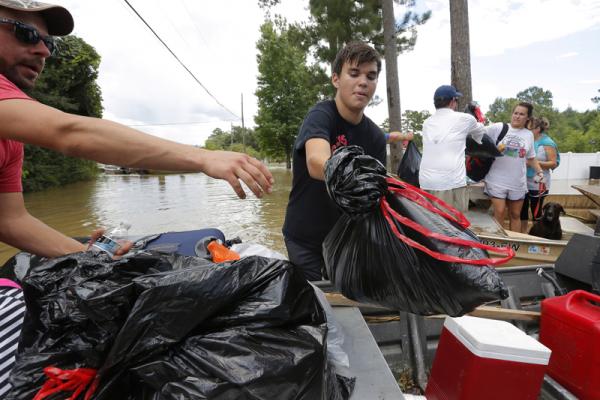Thinking of jumping in your car and driving to Louisiana to help those affected by the flood? Wondering how you could mail some food or hand-me-down clothes to help? If you answered yes — don’t do it.
Yet, that is.
Hit the brakes for a moment before acting. Here’s the deal: Volunteers and resources are going to be needed. In a recent Humanitarian Disaster Institute study, we found that social and spiritual support was vital to fostering resilience among flood survivors.
However, being a spontaneous unaffiliated volunteer (what we call an SUV) is likely to cause more harm than good. Sending supplies before communities are ready to receive them isn’t the way to help either. You will likely only add to the chaos happening there.
Here are some suggestions that will help you help without causing unintentional harm.
Pray
As people of faith, we are called to pray for others, especially for those in need. We don’t think that saying “sending our prayers” is a meaningless gesture; we think it’s a God-ordained means of calling out for divine help. In times of disasters we shouldn’t see prayer as an afterthought, but rather as one of the most powerful things we can do to help.
It’s encouraging to see that a LifeWay Research study , conducted in collaboration with Max Lucado, found Christians regularly pray for others impacted by natural disasters. We have example after example throughout the Scriptures of the power of prayer, and should pray with confidence that our prayers will be heard. Today is a good day to pray for suffering people in Louisiana.
Know why you want to help
You are more likely to run into or cause trouble if you get involved in disaster response for the wrong reasons. Make sure you are helping for the right reasons. Good reasons for wanting to help should be inwardly motivated: You want to help others for the sake of helping others. That is, you want to help because you believe it’s the right thing to do.
On the other hand, if your desire to help is being driven by external motivations, like the possibility of personal gain or benefit, you should hold off from going. Examples might include wanting to help to be “in the action,” to see what is going on, or because you want to be known for doing “good.” Well-meaning but poorly thought out help is the kind of help that no one needs.
Help through proper channels
Look for ways to help through established relief groups, ministries, community organizations, and the like. After Hurricane Katrina, a local leader told our Wheaton College research team, “Volunteers were one of the biggest blessings after Katrina, and volunteers were one of the biggest curses after Katrina.” By “curse” he was referring to those SUVs again — spontaneous unaffiliated volunteers — who just showed up on their own accord and ended up adding to the havoc.
SUVs are more likely to get in the way of trained responders, divert resources from survivors, and contribute to the already taxed local infrastructure. If you want to do something now, that’s good, but realize that some people are better-prepared to act now because they prepared last year. So, partner with them.
Make sure your help matches actual needs
We should give the people of Louisiana time to voice their needs and then respond accordingly. Before you help, make sure you are keeping your focus on the survivors’ actual needs. A good rule of thumb: “Aid happens where need meets resources.”
Don’t assume you know what survivors need. If your help is going to make a positive difference, it needs to match up with what the actual needs on the ground are right now, and with what those needs will be later. If it’s about you — what you have to give or what you can do — it’s probably not going to help them.
Give financially
Giving money now is one of the most effective ways you can help in the immediate aftermath of a catastrophe. Yes, giving a monetary donation can feel a bit sterile. Yet, giving to those on the ground means your dollars will be utilized immediately and where they are most needed. To make sure your dollars go to work, give to established relief organizations and nonprofits.
Local community organizations such as churches may also start to manage donations, which can be another great place to give. Many of these groups already possess the skills, know-how, and resources to respond effectively. They are also more prepared to handle the large influx of donations to follow.
Research has shown the vast majority of giving is done in the early phase of disaster response and often runs dry during later stages of recovery. Thus, consider giving now and again later.
When to send resources and deploy
There will be a time and place for you to deploy or to give resources. But for most people reading this article, now is not the right time. Likely in the next few days or weeks, specifics on what is needed and how others can help will start to emerge. Organized ways of connecting and getting involved will also start to become available. The time to act is after this sort of information and avenues for volunteering become apparent.
We can relate to wanting to pick up and go help as images from the flooding have begun to emerge. However, you need to resist the urge to self-deploy or to send resources, at least for the moment. A desire to help is good; doing things that actually help is better.
Got something to say about what you're reading? We value your feedback!


